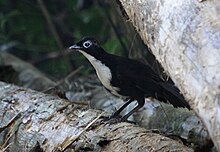Orthonychidae
| Logrunners | |
|---|---|

| |
| Male Australian logrunner | |
| Scientific classification | |
| Kingdom: | Animalia |
| Phylum: | Chordata |
| Class: | Aves |
| Order: | Passeriformes |
| Family: | Orthonychidae G.R. Gray, 1840 |
| Genus: | Orthonyx Temminck, 1820 |
| Species | |
| |
The logrunners (Orthonyx) are a clade of birds which comprises three species of passerine birds endemic to Australia and New Guinea. Some authorities consider the Australian family Cinclosomatidae to be part of the Orthonychidae. The three species use their stiffened tails to brace themselves when feeding.
The Australian logrunner, Orthonyx temminckii, is from northeastern New South Wales and southeast Queensland, where it is very local in its distribution, and strictly terrestrial in its habits. The wings are barred with white, and the chin, throat and breast are in the male pure white, but of a bright reddish-orange in the female. The remiges are very short, rounded and much incurved, showing a bird of weak flight. The rectrices are very broad, the shafts stiff, and towards the tip divested of barbs.[1] The population which is found locally in New Guinea is now generally considered a separate species, the Papuan logrunner, Orthonyx novaeguineae.
The chowchilla, Orthonyx spaldingii, from north-east Queensland, is much larger than either species of logrunner, and has a jet-black plumage, the throat being white in the male and orange-rufous in the female.[1]
Taxonomy[]
The fossil record does not much help to determine the affiliations of the Orthonychidae. Three prehistoric species are known to science. The very large Orthonyx hypsilophus from Fossil Cave and an undescribed species found in which was a bit smaller than the Australian logrunner are probably of Late Pleistocene age.[2] Orthonyx kaldowinyeri[3] is known from Middle or Late Miocene deposits of Riversleigh; it is the oldest and smallest species known to date (Boles, 1993).
Species[]
| Image | Scientific name | Common Name | Distribution |
|---|---|---|---|
| Orthonyx novaeguineae | Papuan logrunner | New Guinea | |
 |
Orthonyx temminckii | Australian logrunner | eastern Australia |
 |
Orthonyx spaldingii | Chowchilla | Australia. |
Behaviour and ecology[]
Logrunners are semi-terrestrial birds of weak flight. They are strictly carnivorous, with insects and larvae being their chief food, whilst the larger chowchilla will also eat small lizards.[4] They find their food by digging in the soil, using their spiny tails as a support in the wet forest.
Social structure and breeding[]

Logrunners have a somewhat unusual social structure. They are basically monogamous,[4] but male offspring are often retained on the natal territory for more than a year after fledging.[5] Despite this, only the female ever feeds the young; the much larger males stay primarily for the purpose of territorial defence and protecting the female from predation. Similar patterns of retention of young without alloparental care also occur in the speckled warbler,[6] the corvid genus Perisoreus[7] and the bustard genus Eupodotis.
Like the lyrebirds, logrunners typically breed in the southern winter from June to September, though this is often extended depending on weather conditions by a month or more. Both the chowchilla and the Papuan logrunner lay only one egg, whilst the Australian logrunner typically lays two though a few reports exist of clutches of one or even three.[4] The eggs are very unusual in their tubular shape, and are pure white in colour, whilst the incubation period is among the longest for any songbird. The young generally become independent of the female in two to two and a half weeks, which is an exceptionally short time for an insectivorous altricial Australian bird,[5] where parental dependence of forty to sixty days post-fledging is typical.[8] This is probably why, unlike in birds of drier habitats in Australia, alloparental care is superfluous for rearing young and may actually increase the risk of predation. The nests are domed and constructed entirely of sticks, and are located on the ground below a tree. They have special coverings to prevent the extremely heavy downpours typical of the eastern Australian coast from damaging the egg(s).
Males are described as performing dancing antics like those of the lyrebirds.[1]
Lifespan[]
In accordance with their nonseasonal, warm rainforest habitat, logrunners can be very long-lived. The chowchilla, the sole species with any banding data, has an average lifespan of around five years and has been known to live for seventeen.[9]
References[]
- ^ a b c Newton 1911.
- ^ *Boles, Walter E. (1993): A Logrunner Orthonyx (Passeriformes: Orthonychidae) from the Miocene of Riversleigh, North-western Queensland. Emu 93: 44-49. doi:10.1071/MU9930044 (HTML abstract)
- ^ Etymology: kaldowinyeri is the Yaralde (Ngarrindjeri) word for "a very long time ago"; this species is the oldest record of the family found to date. Like the bird, the language is nowadays extinct.
- ^ a b c Higgins, P.J. and J.M. Peter; Handbook of Australian, New Zealand and Antarctic Birds, vol. 6: Pardalotes to Shrike-thrushes. ISBN 0-19-553762-9
- ^ a b Frith, C.B., Frith, D.W. & Jansen, A. 1997. “The nesting biology of the Chowchilla Orthonyx spaldingii (Orthonychidae)”; Emu 97, 18-30.
- ^ Gardner, J. L., Magrath, R. & Kokko, H.; “Stepping stones of life: natal dispersal in the group-living but noncooperative speckled warbler”; Animal Behaviour, 66, 521–530.
- ^ Komdeur, Jan and Ekman, Jan; “Adaptations and constraints in the evolution of delayed dispersal: implications for cooperation”
- ^ Russell, Eleanor M.; “Avian Life Histories: Is Extended Parental Care the Southern Secret?” in Emu 100, 377-399.
- ^ Australian Bird and Bat Banding Scheme; Chowchilla
- Del Hoyo, J.; Elliot, A. & Christie D. (editors). (2007). Handbook of the Birds of the World. Volume 12: Picathartes to Tits and Chickadees. Lynx Edicions. ISBN 978-84-96553-42-2
- This article incorporates text from a publication now in the public domain: Newton, Alfred (1911). "Orthonyx". In Chisholm, Hugh (ed.). Encyclopædia Britannica (11th ed.). Cambridge University Press.
External links[]
- Orthonychidae videos on the Internet Bird Collection
- Orthonychidae
- Monotypic bird families
- Passeri